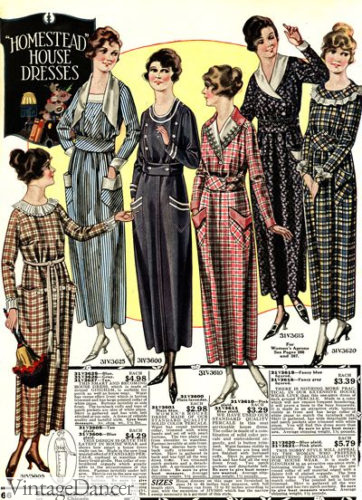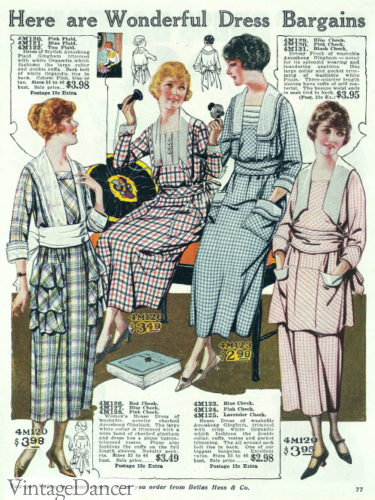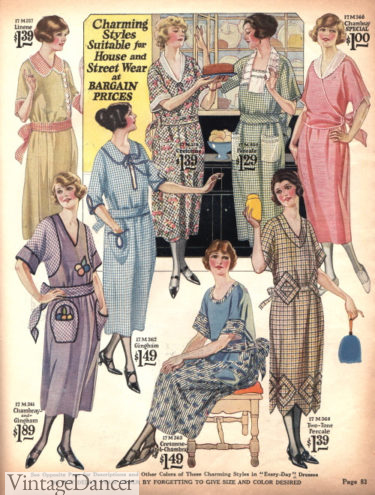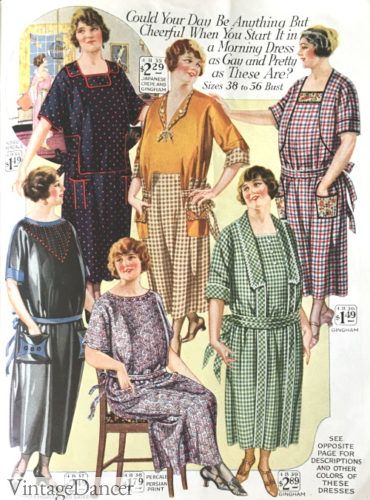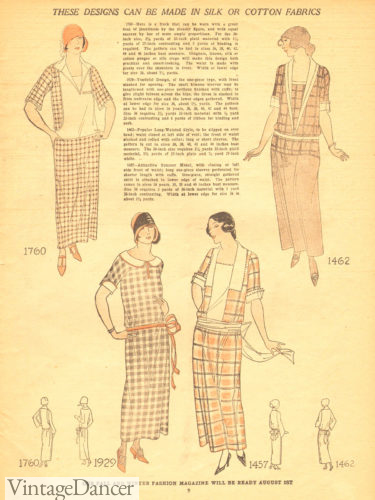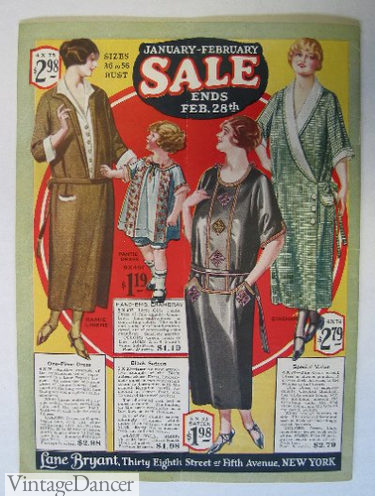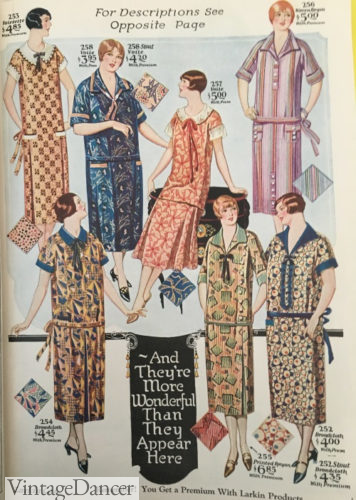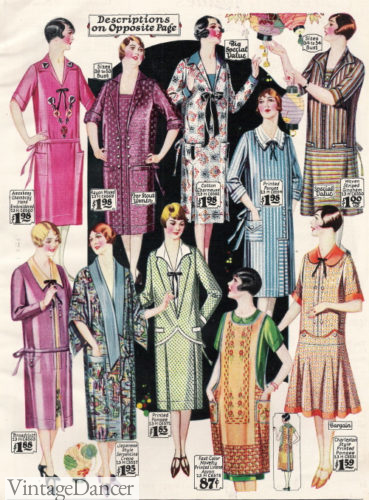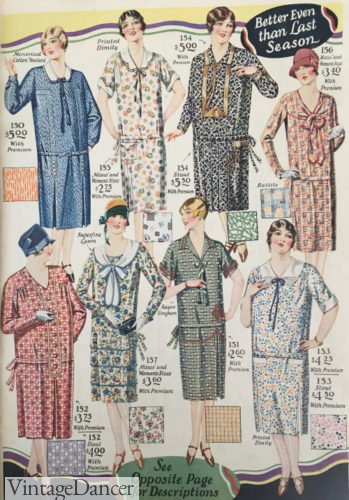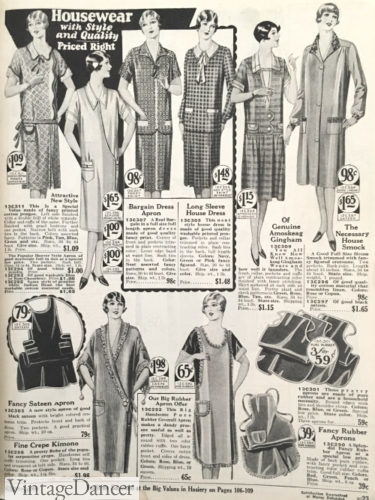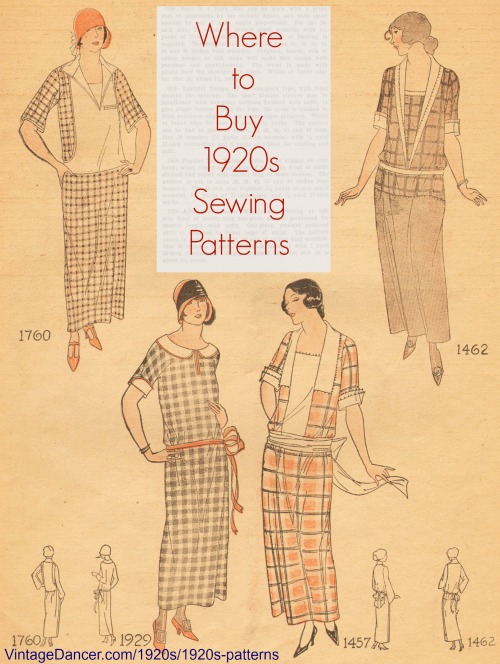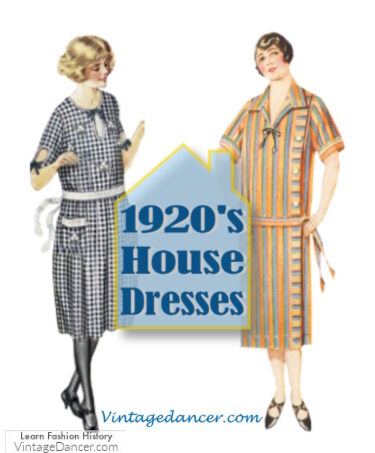
If you do a picture search for 1920s dresses online or in museum collections, you get an overwhelming selection of fancy party dresses. What you don’t see are functional dresses worn by all women at some point in their day. The simple 1920s house dress or “any time of day” dress was a colorful lightweight pullover frock with a single belt and minimal trim. Extremely loose and comfortable, it was ideal for the labors of housework or paid work in the service and manufacturing industries.
Most women did not wear their house dresses outside of the home. They had a few other daytime dresses that were made in nicer materials and trim that were more appropriate to be seen in. This article goes into details of daytime outing dresses.
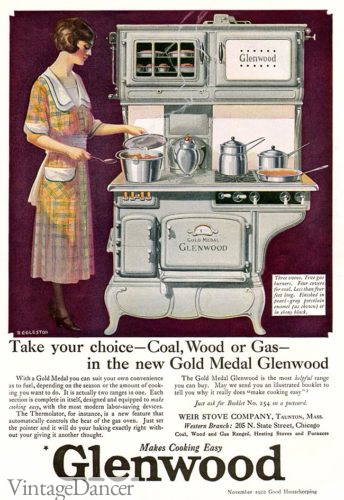
1922 house dress
The 1920s house dress so easy to make, women often sewed their own. Too poor for fabric? Some women would up-cycle cloth flour sacks into dresses and aprons. This is a tradition that continued into the 1940s, when wartime frugality encouraged women to “make do and mend” with what they had on hand.
For durability, house dresses were made of cotton broadcloth, cotton chambray (similar to light denim), cotton percale (soft like bedsheets), Indian headcloth (a smooth, sturdy muslin no longer made today), and cotton gingham (known for its check pattern). A few dresses in summer were also made of linen. In winter, a cotton/wool jersey blend or challis was acceptable. All wool was avoided because it retained odors from the kitchen and harsh cleaning soaps. Yuck!
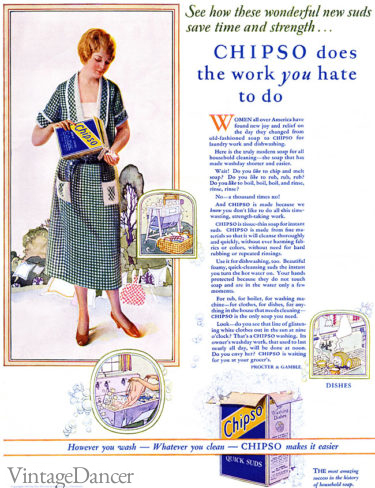
1925 house dress
“Japanese crepes may be bought in a wide variety of colors that are lovely, and that launder beautifully with little ironing. Ginghams in plaids, checks and stripes, and platu chambray ginghams may be very good in color and design. English print, which is none other than our old fashioned calico- a little finer in quality and much better in design makes quaint dresses. For colder days, we may find a good choice of
color and design in challis, which are washable. With all this wealth of color. and materials on the market, there is no excuse for buying ugly, cheap, muddy materials to gallop together, somehow, into a hopelessly homely housedress to be hated by all. ” – The Housewife and Her Working Clothes, By MARGARET KINGERY 1921
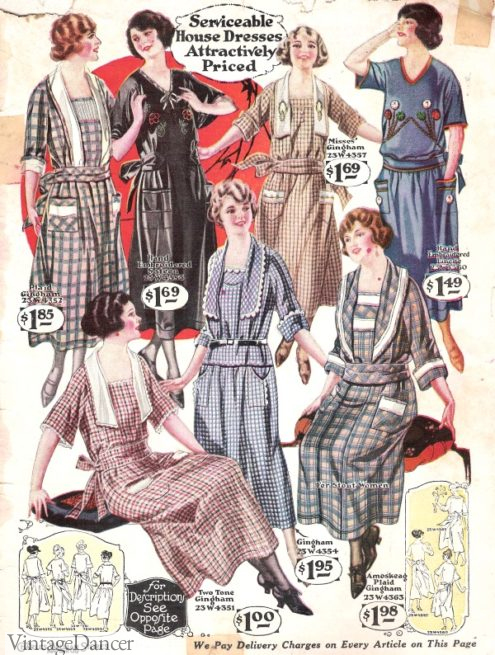
1923 Cotton House Dresses
Gingham, with its brightly colored check pattern, was the most popular print for day dresses. Plaid was the next most popular. It came in all sorts of unique colors such as pink and green with blue, peach and blue with orange, and tan with purple and pink. Sometimes, small flowers were printed over plaids for even more “pop.” Vertical stripe dresses and solid colors rounded out the rest of the day dresses. Colors included a range of cheerful light blues, peach, sage green, rose pink in summer and darker tones of these as well as grey, brown, and even black in the cooler months.
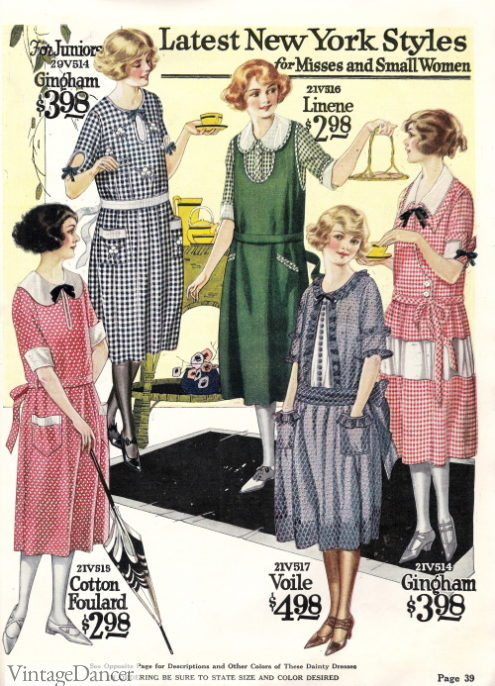
1922- Plaid, checks, stripes, oh my! The house dress was a time to wear colorful prints.
The trimming on day dresses was a lot of what we might think of as craft trim today. White piping, colorful rick rack, and contrast binding finished sleeves, collars, pockets, and belts. Both dress collars and pockets (if the dress even had any) were over-sized. Large round “peter pan” collars, wide and long shawl and tuxedo collars, and men’s suit style notch lapel collars were all seen on day dresses. As the decade progressed, the size of collars and pockets reduced to a more feminine and tailored look.
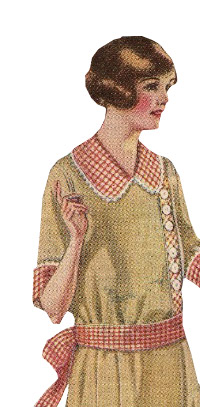
Trimmed peter pan collar in gingham fabric, rick rack, and fabric covered buttons
Wide dress sashes were also gradually replaced by thin narrow self-fabric belts. The sash band started high in the early ’20s and moved lower and lower into the mid and late ’20s.
Around 1924, the day dress took on the fad of mismatching the tops and bottoms. Solid on top and print on the skirt was the most common, although vice versa was favored by many too. The trend was wildly popular for a few years, then died back down to all one-fabric dresses.
House dresses by year:
- 1920 house dress- long and high waist
- 1921 house dresses with tunic effect and large collars
- 1922 house dress and aprons- round collars, natural waist, midi length
- 1923 house dresses for plus size women – long lapels, thin tie belt
- 1924 house and day dresses were nearly identical with long plaid prints and white collars and belts
- 1925 house dresses in the wrap style (R) and Deep V (L)
Mid to Late 1920s House and Day Dresses
The early and mid ’20s, house and day dresses remained mostly the same in style, color, and materials. The lines were blurring between house dress and daytime frock. Many house dresses were as pretty as daytime outing dresses, and daytime dresses were as casual as simple house dresses.
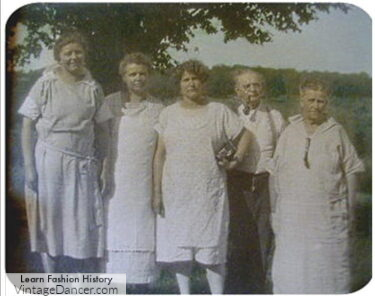
Rare color photo of ladies in their house dresses
By 1927, the progression away from loose and comfortable and into straight and tailored was in place. The movement also reflected a shift away from women as only homemakers to women who worked, played, and volunteered outside of the home.
Household chores were becoming easier thanks to modern appliances. Women spent less time at home and more time out in public. The clothing had to change to match the times. Now, the simple house frock was still colorful but classier, more fitted, more refined with narrowed belts, smaller collars, larger prints, solid colors, and more complicated designs. The look was one where a dress could be worn all day long regardless of where you were.
- 1926 house or day dresses? Very hard to tell the difference!
- 1927 house/day dresses and aprons
- 1928 anytime house/day dresses
- 1928 house dresses and rubber aprons
Aprons exploded in popularity too. For most women, wearing an Anytime of Day Dress with an apron or smock over it was enough for most household duties. By 1929, the wrap dress returned to start off the 1930s with a hybrid dress-apron style to be called the Hooverette.
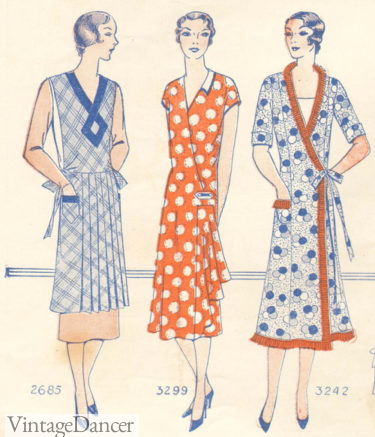
1929 wrap style house dresses return to start the new decade
Continue on to 1920s daytime dresses or 1930s house dresses
Make a 1920s House Dress
I loved the 1922 blue gingham check house dress featured in the top of the article so much so that I had to re-create it. It is a simple drop waist dress with a lightly gathered skirt. I found a new pattern for a drop waist tunic dress at my local fabric store and just adapted it a little by lengthening the skirt and moving the key hole from the back of the dress to the front. The rest was just trim (white lace and black velvet ties.)
House dresses are very simple and easy to make. It is the trim that takes the longest to add on. Read more about my 1920s house dress here.
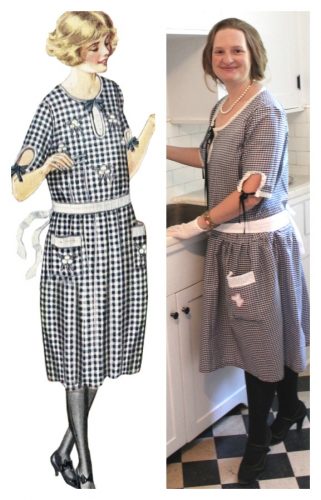
How to make a 20s house dress
The 1923 One Hour Dress is also an excellent pattern to use for an early 1920s house dress. See my tips on using this basic pattern plus examples of what others have made with the pattern.
Sew yourself a 1920s house dress with one of these 1920s sewing patterns
Shop 1920s Style Day Dresses
Ready made 1920s day dresses are not easy to find. I keep my eye out for some options online. In most cases, these simple dresses only need a sash, belt, or pretty brooch to take it from modern to roaring twenties.
I look for house dresses/ housecoats as well as tunic dresses and some peasant dresses in the thrift stores. Linen dresses in simple silhouettes are nearly perfect for the late teens and early 20s. Sometimes, the easiest quick house dress is to wear a simple dress underneath a ’20s style apron.
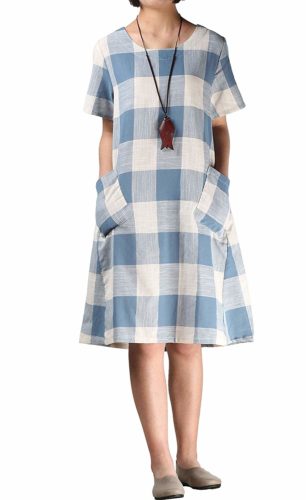
With a sash/belt, this becomes an early 20s house dress.
House Dress Accessories
- Once you have a house dress picked out how to you style it?
- Shoes: Mary Jane, T-strap, or Oxfords with a low 1-2 inch heel. Flats can be found here.
- Stockings: Black or dark nude. Cotton stockings were the most practical. Tights that are not sheer will create the same effect.
- Undergarments: A woman would not have worn a corset or shapewear to do housework. A slip in reasonable to help the house dress hang off the body smoothly.
- Jewelry: None.
- Hats: Optional house cap/mop cap. You could also use a wide scarf as a headband.
- Props: Mop, old fashioned clothes pins, tea cup and pot on a tray, scrub brush, etc.
Need help with your outfit? Just ask!
Debbie Sessions has been teaching fashion history and helping people dress for vintage themed events since 2009. She has turned a hobby into VintageDancer.com with hundreds of well researched articles and hand picked links to vintage inspired clothing online. She aims to make dressing accurately (or not) an affordable option for all. Oh, and she dances too.
